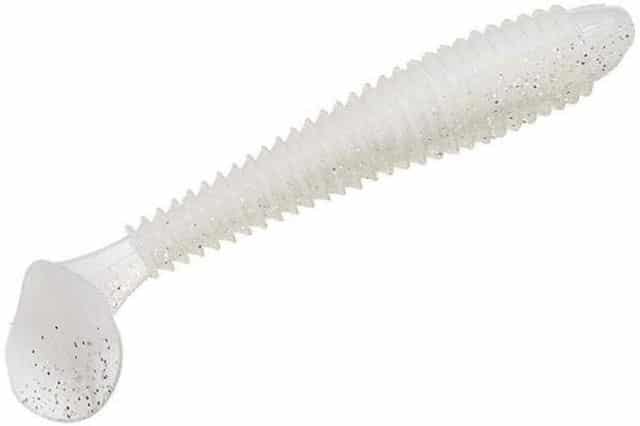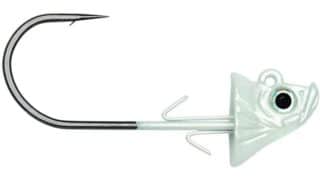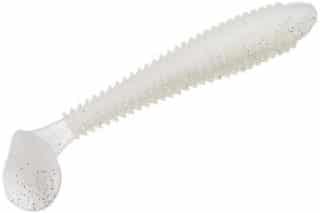Soft-plastic swimbaits are a great option this time of year because they appear very lifelike beneath the surface and mimic baitfish very well. They can be fished fast or slow and used in many different scenarios.
I’ll break down some of the best ways to rig these soft-plastic lures and explain how to utilize them this time of year to increase your catch rate.
What is a Soft-Plastic Swimbait?
A soft-plastic swimbait has a soft body and a shad like appearance. It is designed to look like a baitfish when brought through the water.
There are swimbaits that aren’t soft-plastic. They have hard bodies and much different action. However, we are just talking about those that are soft-plastic in this article.
When it comes to soft-plastic swimbaits, the main way I prefer to rig them during the winter is on a jig head. A swimbait rigged on a jig head is a deadly combo and one of the most productive ways to fish a swimbait during the winter because its falling action imitates dying shad extremely well. It’s a great finesse approach that will catch fish even on the slowest days.

Strike King Rage Swimmer (Rigged on a VMC Swimbait Jig Head)
My favorite swimbait for wintertime is a Strike King Rage Swimmer rigged on a VMC Swimbait Jig Head. The Strike King Rage Swimmer is a very versatile swimbait. It has excellent swimming action and is a great imitation of fleeing shad. The VMC Swimbait Jig Head looks very real and has a lifelike appearance as well.
3 Best Soft-Plastic Swimbaits
As mentioned above, the Strike King Rage Swimmer is my preferred soft-plastic swimbait. I believe it has the best erratic action of any.
However, if I happen to be out of Rage Swimmers, both the Keitech or Reaction Innovations swimbait will do the trick. They are extremely effective lures and their soft body and erratic tail mimic shad beautifully.
2 Best Jig Heads
The VMC jighead is my preference because it looks very real in the water. It’s painted head and lifelike features make it appear just like a baitfish when brought through the water properly.
5 Tips for Fishing Soft-Plastic Swimbaits
Now that you know which swimbaits and jig head to grab, let’s talk about how to use them.
1. Vary Your Sizes
I vary the size of both the swimbait and the jig head depending on my situation.
For example, if the forage in the area I’m fishing is on the small side, I will usually stick with a 2-3 inch swimbait. But, if the baitfish in a certain lake are larger, I will turn to a long 4-5 inch swimbait.

In shallower water, a ¼ – 3/8 ounce jig head works best, while if targeting deeper fish, a ½ – 3/4 ounce jig head is better.
2. Use Shad Colors for Swimbaits in Winter

Pearl white, gray, and light blue colors are usually my go-to swimbait colors this time of year. These patterns appear more like shad than the real bright colors during the winter months.
3. Focus on Cover
Some of the best areas to fish a soft-plastic swimbait include along channels and points, over the top of vegetation and near other shoreline cover.
Try fishing a swimbait parallel to shoreline cover and never give up on a cast. Fish the whole cast until your swimbait is all the way back to the boat, as bass will often strike the lure at the last instant.
4. Retrieve Speed
I adjust my retrieve speed based on water temperatures and how aggressive the fish are at the given time. The colder the water, the slower I’m going to fish the bait and the more I’ll use a yo-yo retrieve, hoping the swimbait off the bottom or around cover, then allowing it to fall back to the bottom. In warmer conditions, I’ll usually work the bait on a steady retrieve.
5. Swimbait Tackle
Anglers can throw soft-plastic swimbaits on either baitcasting or spinning gear. I do a little of both. If using a heavier swimbait, I will usually rig it on a fairly sensitive 7’ medium action baitcasting rod paired to a reel with a 6:4:1 gear ratio. I spool that reel with 10-15 pound braided line tied to a 10-14 pound fluorocarbon leader.
If I’m using a smaller swimbait, I prefer a 7’ medium action spinning rod paired to a reel with a 6:4:1 gear ratio. I spool it with the same braided line tied to a 10-12 pound fluorocarbon leader. The spinning tackle allows me to cast a light lure way further than if I was using a baitcasting combo.
When fishing with a soft-plastic swimbait, remember you’re trying to imitate baitfish. In addition to fishing cover along the shoreline, if you see bass chasing shad at the surface or have identified a school of fish on your graph or depth finder, try these soft-plastic lures. Their shad-like appearance is likely to trigger a strike!
Feel free to leave a comment down below and let us know how your next outing goes!
